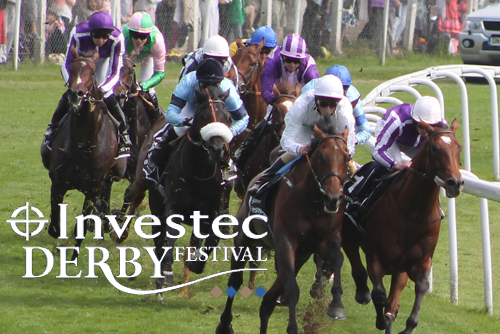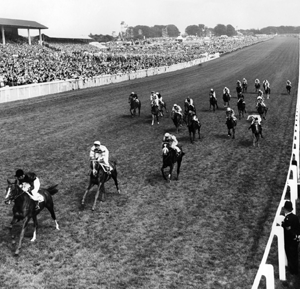
Epsom Derby Betting Guide

Every organizing committee of a sporting event naturally likes to think that their event is the best. But when the Epsom Derby (better known to England residents as the Derby Stakes, or even simply “The Derby”) refers to itself as “without a doubt, the greatest flat race in the world,” officials just might be right.
Open to three-year-old Thoroughbreds and contested at just over 1 ½ miles on the historic turf track at Epsom Downs Racecourse, the Epsom Derby is the richest horse race in Britain and is nicknamed the “Blue Riband” (meaning blue ribbon for first prize) of turf racing. Approximately 130,000 people jam Epsom Downs each June to see who will become the next in a long line of champions that dates all the way back to 1780.
In this Epsom Derby betting guide, we’ll spell out what you need to know to bet on England’s most prestigious horse race.
When Is the Epsom Derby?
The Epsom Derby is held annually on the first Saturday of June at Epsom Racecourse in Surrey, England.
The actual race starts at 4:30 p.m. local time, which is 11:30 a.m. Eastern. NBC Sports Network broadcasted the event in the United States in 2017.
Best Sites for the Epsom Derby
Residents of England have no shortage of options when it comes to betting on the Epsom Derby. Since gambling in the United Kingdom is regulated by the government, Brits can bet on The Derby at the track, at kiosks located throughout their city, or with numerous online betting sites.
Thanks to the internet, non-England residents can bet on the race quickly and easily as well. Epsom Derby odds should be available at practically every betting site that accepts North American players. We’ve listed the best of those sites below, based on their history of payouts, strong customer service, player-friendly odds, sign-up bonuses, and other factors.
| RANK | BETTING SITE | SIGN UP BONUS | GET STARTED |
|---|---|---|---|
 Betway Betway |
up to €30 Free Bet | VISIT SITE | |
 Spin Sports Spin Sports |
100% up to €200 | VISIT SITE | |
 888sport 888sport |
100% up to €200 | VISIT SITE |
Previous Epsom Derby Winners
Sea the Stars is the latest in a long list of great horses to win the Epsom Derby. The Irish Thoroughbred’s win at Epsom in 2009 made him the first colt in 17 years to win the 2000 Guinea, Derby, and Eclipse Stakes, and he also claimed the International Stakes, Irish Champion Stakes, and prestigious Prix de l’Arc de Triomphe that season.
There have been two dead heats in the history of the Epsom Derby, one of which was declared a tie (St. Gatien and Harvester in 1884) and another which required a rematch later that afternoon (Cadland beat The Colonel in 1828). Six fillies have won the race, but none since Fifinella in 1916.
Below is the long list of the Epsom Derby’s all-time champions:
- 2017: Wings of Eagles
- 2016: Harzand
- 2015: Golden Horn
- 2014: Australia
- 2013: Ruler of the World
- 2012: Camelot
- 2011: Pour Moi
- 2010: Workforce
- 2009: Sea the Stars
- 2008: New Approach
- 2007: Authorized
- 2006: Sir Percy
- 2005: Motivator
- 2004: North Light
- 2003: Kris Kin
- 2002: High Chaparral
- 2001: Galileo
- 2000: Sinndar
- 1999: Oath
- 1998: High-Rise
- 1997: Benny the Dip
Track Info
The race track at Epsom Downs Racecourse has the oddest configuration of any track that hosts a major race.
Rather than being a complete circuit, the grass track is shaped like a horseshoe, shortening the straightaways and making more than half of the Epsom Derby a long turn. The short straightaway at the beginning requires horses to run uphill, the turn and second straightaway are mostly downhill, and there is a sharp incline once again right before the finish line.
Epsom Downs can accommodate crowds of as many as 130,000 people, including those who watch the event for free from a nearby public area that overlooks the course.
Epsom Derby Records
With nearly 250 years of history, Epsom Racecourse has certainly seen more than its share of tremendous performances. Here are just a few of the all-time records for Epsom Derby participants.
Fastest Time
The fastest winning Epsom Derby time ever recorded at Epsom Downs came in 2010 when Workforce completed the race in 2:31.33 to win by seven lengths. Workforce’s convincing victory came by the third-largest margin in the history of the event and also marked the first time that a horse who was beaten in the Dante Stakes (an English 1.28-mile Group 2 flat race for three-year-olds) went on to win the Epsom Derby.
Five faster winning times have been documented in the history of the Epsom Derby, but all of those times were posted from 1940-45. Races in those years were held at Newmarket Racecourse, a shorter track that hosted the Epsom Derby during both World War I and World War II.
Biggest Winning Margin
The majority of Epsom Derby races have been determined by at least one length, but only one of them has been decided by more than eight. That time came in 1981 when heavy favorite Shergar cruised to a 10-length victory despite posting the slowest winning time (2:44.21) in nearly 40 years.
Prior to that, the largest margin of victory was Manna’s eight-length win in 1925. Workforce (2010), Slip Anchor (1985), and Troy (1979) are tied for the third-largest winning margin, each winning by seven lengths.
Biggest Field
Injuries to horses and jockeys over the years at Epsom Racecourse forced Epsom Derby organizers to cap the field at 20 runners in 2003. The year before that decision was made, a horse had to be put down after suffering an injury during a 24-horse, 1.5-mile race at the racecourse.
Prior to that, however, it wasn’t uncommon to see field sizes in the 30s for the Epsom Derby. The most horses to ever participate in the event was the 34 who ran in the 1862 race.
Smallest Field
The smallest field in Epsom Derby history came in 1794 when only four horses participated in the race. Curiously, 49 horses had entered the Derby that year (including paying the entrance fee), but 45 of them ended up not competing.
Winner with the Highest Odds
Three horses have brought home triple-digit returns for their backers in the Epsom Derby, though none have those have come in the last century. 1898 champion Jeddah, 1908 winner Signorinetta, and 1913 victor Aboyeur each opened at 100:1 odds, while the highest-paying winners since then have been Snow Knight (50:1) in 1974 and Wings of Eagles (40:1) in 2017.
Terimon came close to shattering those records in 1989, when he finished second as a 500:1 prayer. The British Thoroughbred was the oldest horse in the race and went off with the longest odds, then finished five lengths behind favorite and reigning 2000 Guineas champion Nashwan. Even though Terimon couldn’t quite pull off the outright win, he still owns the record for longest odds ever by a placed horse in the event.
Most Successful Trainers
The record for most Epsom Derby wins by a trainer was set nearly 200 years ago and has since been matched twice. Robert Robson was the first trainer to win seven Derby titles (the last coming in 1823), while John Porter (last in 1899) and Fred Darling (last in 1941) also produced seven Epsom Derby winners.
Sir Michael Stoute leads all active trainers with five Epsom Derby wins, including fastest-time record-holder Workforce in 2010.
Most Successful Jockeys
Lester Piggott stands alone as the winningest jockey in Epsom Derby history, riding to victory nine times during his illustrious career. Piggott won back-to-back titles in 1976-77 aboard Empery and The Minstrel, respectively, and his first and last Epsom wins came nearly 30 years apart. Piggott competed in the race 36 times.
Steve Cauthen is the lone jockey to ever lead horses to victory at both the Epsom Derby and Kentucky Derby. The American rider was aboard eventual Triple Crown winner Affirmed in his 1978 Kentucky Derby win, then rode both Slip Anchor (1985) and Reference Point (1987) to wins at the Epsom Derby later in his career.
History of the Epsom Derby

The Epsom Derby’s proper name is actually the Derby Stakes, named after Edward Smith-Stanley, the 12th Earl of Derby.
After Lord Derby’s horse Bridget won the 1778 Oaks Stakes (coincidentally, another race that Derby helped create), he and others thought of a similar race for colts during a party celebrating Bridget’s victory. Derby won a coin toss with St. Charles Bunbury for the rights to name the new race, and the first Derby Stakes was contested the following year (Bunbury’s horse Diomed won the inaugural title). The Oaks and the Derby Stakes have since become the only races in the world to produce an uninterrupted line of winners since the 1780s.
Although the first four Derby Stakes were run at a one-mile distance, organizers increased the distance to 1.5 miles in 1784. That distance has remained the same ever since, even though the starting point of the race was moved slightly in 1848 and then again in 1872.
The Derby Stakes was a mid-week event until 1995 when the date was changed from the first Wednesday in June to the first Saturday of the month. The Derby Stakes was first televised in 1927 on BBC, and regular television coverage of The Derby began in 1960.
Here Are Some Other Notable Milestones in the History of the Derby Stakes:
- 1801: Eleanor becomes the first filly to win The Derby, then also wins The Oaks the next day
- 1946: Queen Elizabeth (then Princess Elizabeth) attends The Derby for the first time
- 1953: Sir Gordon Richards wins his first Derby title in his 28th attempt as a jockey
- 1954: Lester Piggott collects his first of nine career Derby wins as a jockey
- 1970: Nijinsky wins the Derby on his way to collecting the British Triple Crown, the last horse to accomplish the feat
- 1996: Alex Greaves is the first female jockey to compete in The Derby
- 2010: Workforce posts a record time of 2:31.33
- 2012: Aidan and Joseph O’Brien become the first father-and-son trainer/jockey combination to win The Derby
Summary
Whether you know it as the Epsom Derby, the Derby Stakes, or simply The Derby, there’s no questioning that Epsom’s historic race is the granddaddy of ’em all when it comes to races for three-year-old Thoroughbreds.
Dating back long before the North American Triple Crown races (including the Kentucky Derby, whose name was inspired by the original Derby), the Epsom Derby is a can’t-miss event for even the most casual of horse racing fans. We strongly recommend that you make an effort this year to tune in, place a bet with one of the top Epsom Derby betting sites, and soak up the rich history, tradition, and action!